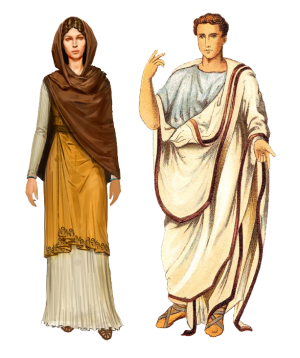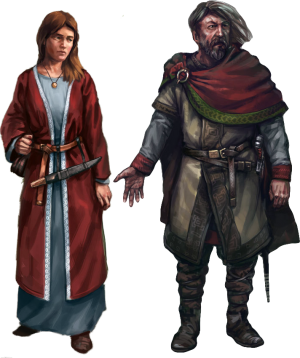m (→Roman Fashion) |
m (Links to existing pages added by LinkTitles bot.) |
||
| (2 intermediate revisions by the same user not shown) | |||
| Line 1: | Line 1: | ||
= Fashion in the Uther Period = | = Fashion in the Uther Period = | ||
After Aurelius Ambrosius conquered Britain many new trends are set all over [[Logres]]. New ideas of clothes and lifestyle is imported from the continent, and mixed with new styles of clothes inspired by the invading saxons. '''Clothes from this period usually go out of fashion every other year.''' | After [[Aurelius]] Ambrosius conquered [[Britain]] many new trends are set all over [[Logres]]. New ideas of clothes and lifestyle is imported from the continent, and mixed with new styles of clothes inspired by the invading [[saxons]]. '''Clothes from this period usually go out of fashion every other year.''' | ||
== Roman Fashion in the Uther Period == | == Roman Fashion in the Uther Period == | ||
[[File:roman_c.png|300px|right]] | [[File:roman_c.png|300px|right]] | ||
In cities or at court men wear long tunics and at times a toga over it, much the same as it was as during the earlier Roman Period. | In cities or at court men wear long tunics and at times a toga over it, much the same as it was as during the earlier [[Roman Period]]. | ||
Women’s fashion changes more than men during the period, but not to any significant degree. In cities or at court they wear long and open dresses in light fabric. | Women’s fashion changes more than men during the period, but not to any significant degree. In cities or at court they wear long and open dresses in light fabric. | ||
| Line 11: | Line 11: | ||
Roman slaves wear nothing or very little at all, although the hard british weather forces even the slaves to wear thick woolen clothes. | Roman slaves wear nothing or very little at all, although the hard british weather forces even the slaves to wear thick woolen clothes. | ||
<h2 style="clear:both">Cymric Fashion in the Uther Period</h2> | <h2 style="clear:both">[[Cymric]] Fashion in the [[Uther]] Period</h2> | ||
[[File:uther-clothes.png|300px|right]]The most common fashion in this period is the continental-cymric style, somewhat equivalent to real life 10th-11th century clothes. | [[File:uther-clothes.png|300px|right]]The most common fashion in this period is the continental-[[cymric]] style, somewhat equivalent to real life 10th-11th century clothes. | ||
Men wear long tunics and a thinner belt than earlier periods, often with an over-tunic to keep the warmth. A new addition is the cape-style, which is now prominent. The cape is fastened with a large belt buckle. | Men wear long tunics and a thinner belt than earlier periods, often with an over-tunic to keep the warmth. A new addition is the cape-style, which is now prominent. The cape is fastened with a large belt buckle. | ||
Women wear long dresses, often with several layers. pagan and unmarried women carry the hair let out, and married women wrap the hair in white cloth so symbolise purity. | Women wear long dresses, often with several layers. pagan and unmarried women carry the hair let out, and married women wrap the hair in white cloth so symbolise purity. | ||
Latest revision as of 10:09, 22 August 2017
Fashion in the Uther Period
After Aurelius Ambrosius conquered Britain many new trends are set all over Logres. New ideas of clothes and lifestyle is imported from the continent, and mixed with new styles of clothes inspired by the invading saxons. Clothes from this period usually go out of fashion every other year.
Roman Fashion in the Uther Period
In cities or at court men wear long tunics and at times a toga over it, much the same as it was as during the earlier Roman Period.
Women’s fashion changes more than men during the period, but not to any significant degree. In cities or at court they wear long and open dresses in light fabric.
Roman slaves wear nothing or very little at all, although the hard british weather forces even the slaves to wear thick woolen clothes.
Cymric Fashion in the Uther Period
The most common fashion in this period is the continental-cymric style, somewhat equivalent to real life 10th-11th century clothes.
Men wear long tunics and a thinner belt than earlier periods, often with an over-tunic to keep the warmth. A new addition is the cape-style, which is now prominent. The cape is fastened with a large belt buckle.
Women wear long dresses, often with several layers. pagan and unmarried women carry the hair let out, and married women wrap the hair in white cloth so symbolise purity.

